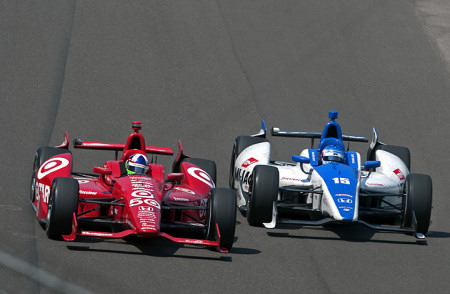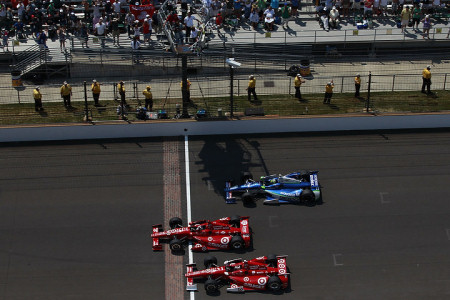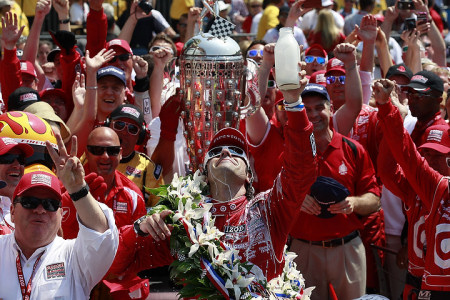The Way It Is/ Franchitti, Ganassi and Honda's superb comebackby Gordon Kirby |
 Many people had counted Dario Franchitti, Scott Dixon and Chip Ganassi's team out of contention at Indianapolis this year. As everyone knows, Honda was outpaced by Chevrolet in the opening four IndyCar races and the Chevrolet teams comprehensively blew-off their Honda-powered competitors in qualifying. Prior to last Friday's 'Carburetion Day' it looked like Chevy's lead teams Penske and Andretti were going to dominate this year's 96th Indy 500.
Many people had counted Dario Franchitti, Scott Dixon and Chip Ganassi's team out of contention at Indianapolis this year. As everyone knows, Honda was outpaced by Chevrolet in the opening four IndyCar races and the Chevrolet teams comprehensively blew-off their Honda-powered competitors in qualifying. Prior to last Friday's 'Carburetion Day' it looked like Chevy's lead teams Penske and Andretti were going to dominate this year's 96th Indy 500.
But 'Carb Day' provided a strong hint that both Honda and Ganassi's team might have turned the tables. With new 'step two' engines Franchitti and Dixon finished the day at the top of the time sheets. Both ran plenty of laps, as they had through the week of practice and qualifying, and in the race Dario and Scott worked together superbly, drafting their way to the front, then working together to lead the race and conserve as much fuel as possible. It was teamwork at its very best and it paid off as they scored a resounding one-two finish. "You know how unhappy I was on qualifying day," Franchitti remarked. "I was angry. As I said, I had no expectations, but I thought we'd be quick and we weren't. I think I was fairly honest and clear about being upset with it. The Honda guys have been working hard since before the start of the season, but they've been playing catch-up. "They made the turnaround from Sunday to Carb Day and it was very impressive. We've been in a battle together a few times before and they continue to amaze me. When we're up against Chevy, who are smart people, I think what Honda did today to beat them and the turnaround from last week is something very special."  © LAT USA "There were a lot of unknowns going into today's race," Chip commented. "We had no idea where we were going to run. Believe me, we came in here with more unknowns this year than any other year. In our race meeting, all we talked about were unknowns. We had to be prepared for a lot of different scenarios." Like many of us, Ganassi was delighted to see a race to the finish unencumbered by worries about fuel consumption. "It was a great race," he declared. "There was a helluva lot of passing going on and at the end there wasn't anybody saving fuel. Mid-race we were saving fuel on the 100-lap mark, coming up with a strategy of how we were going to get to the finish. At the end, it was as fast as anybody could go, I assure you." Ganassi's team boss Mike Hull said the team's poor qualifying results galvanized them into action in pursuing the thorough preparation required to win the 500. "I think it was a blessing in the way we qualified so miserably," Hull observed. "We're not used to starting that far back. Running in the turbulence at Indianapolis is not what we've done for quite a long time and it makes you work really, really hard on your race car. "We had a really, really good Thursday before qualifying weekend with Dario and Scott. We found a good mechanical balance and carried that into Sunday after qualifying. I think Dario and Scott did half a race apiece those two days. We learned an awful lot about how to be ready mechanically to race here and Honda certainly jumped their game up a bit with the race engines we received and also the mileage and mapping and all the things they work on." Hull said he believed both of his drivers were better set-up for the race than anyone else. "I would say that unlike some people, our tires were really good all the way through the run," he remarked. "We didn't give up anything all the way through those long, green runs. We worked right from the first day we were here on the race. You always try to match the mechanical grip level of the race car for a full run of approximately 30 laps. Then you match the aero load to that. If you can get your tires to be really good when they come off on that full green run, that's our goal. "When we started here, we weren't in that position. It took us several days to be in that position. We were very fortunate with the weather for two reasons. One was it got warmer and warmer all the way to the race. That helped us. And there was no rain so we ran every day. "We had really good race cars. We knew that by Thursday of the qualifying week. It allowed us to work extremely hard again on Sunday with a huge menu of items to create grip. I think we matched the balance of the car to the tires and the engine today better than anybody else." As he's said before, Huill believes Franchitti and Dixon work together better than any other two-car team in big-time motor racing today. "In Dario's case we have a guy that hasn't reached his midlife crisis yet, that drives with the experience of his age. But he comes to work every day with the enthusiasm and intent of an 18-year old. That's a pretty tough combination to beat. "And then he's absolutely unselfish. In motor racing around the world with two-driver teams, how many teams can say that? I don't think there's one, except this team. Of course, I have a biased opinion. The drivers that we have work together as one and that got us to the front today. That's made a big difference over time."  © LAT USA "It's great that what we saw today was a motor race," Hull commented. "We didn't see a fuel economy run for the last fifteen laps of the race. I think that's really important for IndyCar racing. I think the race today was fantastic and it would be great if you could pull the strings for every race so everybody had full fuel for the last ten or fifteen laps." Honda Performance Development's assistant vice president Steve Eriksen discussed the development work Honda put into its latest engine. "If you look at the data on top speeds we're there at Chevrolet's level or above," Eriksen said. "We've been progressing to a plan and the things that are out of our control we can't really do anything about. But I think what you saw in Carb Day was repeated in the race. "I'm pleased with the step up that we were able to apply to our second engine this year. We were the first ones in the paddock to reach the mileage limit on the first engine. We're very pleased that we showed reliability to get to that point and if you look at top speeds the Hondas are right there or better. "You've got five engines in a season so each one of those five can have a different piston stack, for example. So you're going to concentrate on refining the details of the pistons to get a better combustion process and be more efficient. I think the fuel efficiency of this latest engine is a step up from what we had before and certainly a step up on power as well. We've laid out the plan for the year and each one of those five engines will be a step up based on what we can do within IndyCar's homologation specifications." Eriksen commented about the dispute with Chevrolet about permitting Honda a different inlet tract. "Certainly we didn't expect that the spec hardware that IndyCar provides would have had the lack of parity that it did at the beginning of the season," he said. "Our expectation, and I think originally IndyCar's expectations, was that the parity issue would be addressed and we both started on a level playing field from the spec hardware standpoint. "That put us at a disadvantage through no fault of our own so that affected somewhat the performance for those races that we couldn't apply the improved hardware. We expected to be able to run it at Long Beach but everyone knows how that turned out. "The other thing is that GM and Ilmor elected to change all their engines at Long Beach and take a penalty. We have not done that. We followed IndyCar's direction which says you run the first engine up to its mileage limit and then you change to the next engine. That's the way the process is supposed to work.  © LAT USA "Ilmor chose to put their engines in early. Therefore, they had the chance to step-up in performance at that opportunity. But there's no free lunch. If you put an engine in early then you've got penalties on the back end." Eriksen said HPD's engineers are delighted to have plenty of development work on their plates this year. He's particularly pleased to be working on direct injection. "That's really wonderful. I'm so pleased that's part of the spec of this series because it really shows the technology side of IndyCar. It's one thing to do direct injection with gasoline but another thing with the flow rates of ethanol. Running at 12,000 rpm with ethanol your injection window is so short that you've got to get so much fuel in there that it's not really atomized at very high pressure. "I think it's really neat and I was pleasantly surprised by how quickly we were able to get to a good solution on direct injection. Having never done direct injection before our guys did a really good job and working with our vendors we were able to narrow down the solution pretty early on. That really put us at ease because that was one big technological hurdle that we had to deal with. We're excited about all the possibilities for refinements of injectors, the spray patterns and atomization and all the things you need to do to make it more efficient." Obviously, Eriksen and his engineers at HPD were delighted to win this year's Indy 500. "It's thrilling," he grinned. "Hopefully it carries on from here. Look at our history. When we came into this series in 2003 we didn't have a lot of wins, but by 2004 the program was in full heat. And looking at the sports car side of things we went out in the first year and won at Sebring and then we didn't have any more wins and then the next year we were gangbusters. I think realistically we can be in that situation this year. You'll see a step change at each of the four new steps this year and of course, it's the same for Ilmor. They'll be doing the same thing. "It's exciting and it's got everybody's imagination back. For us, everybody's paying rapt attention to the races now in a way that we kind of got away from when we were the sole supplier. That's why we wanted the competition back, to capture the hearts and minds of our engineers. "In some ways it's been good for our younger guys. You hate to say it, but it's good for them to experience a loss because they know what that feels like. When you've been winning so long you forget what losing's like.  © LAT USA "It's going to get very interesting as the season goes on because of the chaos that's going to result in the manufacturers being on very different schedules. It already has. But as the season goes on it's only going to get more fractured to the point where it's going to be really interesting to watch and try to keep track of what engine people are on." Bobby Rahal's regular driver Takuma Sato came closer than anyone to beating the Ganassi team at Indianapois. Rahal's team introduced Honda to Indy car racing back in 1993 and '94 so he has plenty of Honda experience. Bobby analysed the battle between Honda and Chevrolet so far this year. "I think you have to acknowledge that Ilmor has done an extremely good job with the Chevy program," Rahal said. "There's a tremendous amount of Indy car experience at Ilmor and I think frankly that was their advantage in the short term. Most if not all the people at Ilmor have years of experience with different Indy car engines, particularly turbocharged engines. "On the Honda side I think there's a lot of newer people with less experience. The management of HPD however is very experienced and guys like Roger Griffiths, for example, are tremendous. Roger is a very, very hard worker and he communicates that work ethic to his colleagues. "Going with a single turbo versus twin, I think the jury is still out on that whether that's the way to go or not, or whether the twin is the way to go. There have been some reliability issues up to this point, but it's not been across the board. It seems to come hit or miss. "Honda has reacted very aggressively to the situation. Honda's history is not one of failure. It's one of success. So I think it's galvanized HPD's people here in America and Honda's people in Japan to meet the challenge. "Initially, Chevy had a bit of an advantage," Bobby concluded. "They were stronger on fuel mileage for sure and I think the Chevy has been a little bit easier to drive on the street courses because the response by the twin turbo is a little better than the single turbo. Obviously, on qualifying day they were much more powerful, but as I say, Honda reacted very aggressively and showed what they can do in the race. I believe Chevy has awakened a sleeping giant and I think the race is on now." |
Auto Racing ~ Gordon Kirby Copyright 2012 ~ All Rights Reserved |
